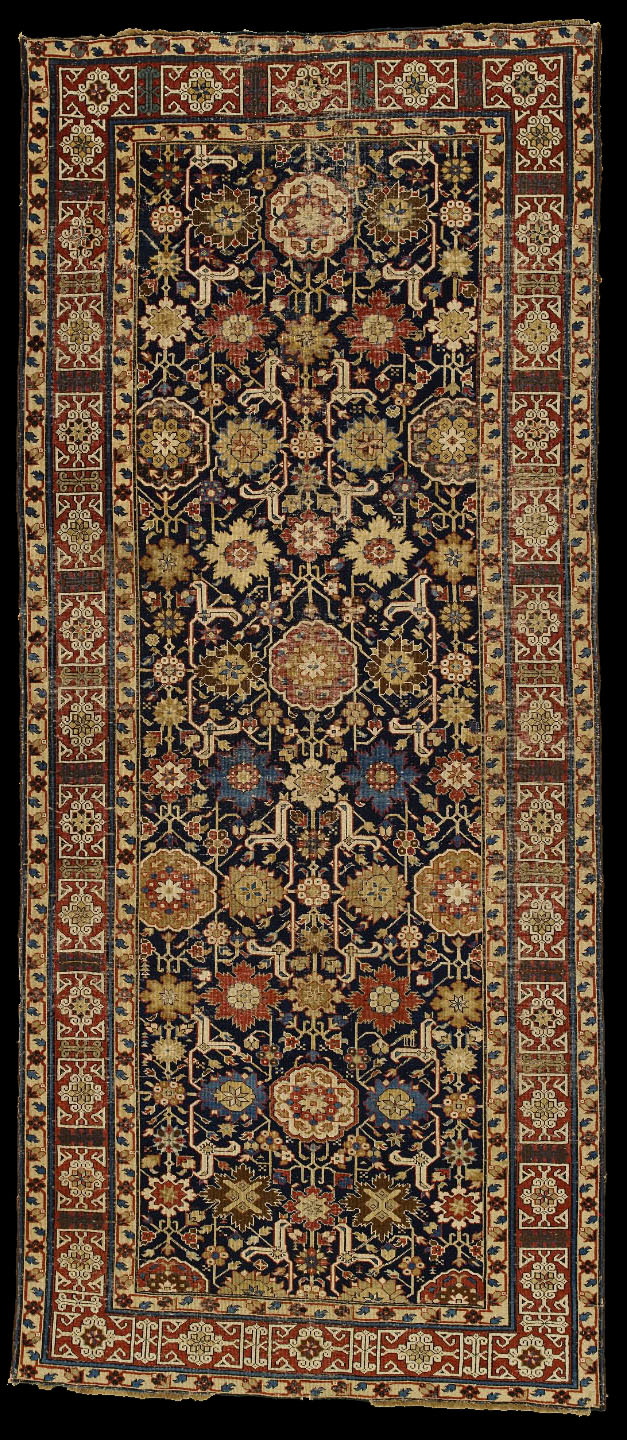|
Antique Baku long rug,
first half 19th century, Eastern
Azerbaijan. Powerhouse Museum, Australia
This fine Afshan rug is from
the Shirvan district in the Kuba region of the northern Caucasus. The term
'Afshan' refers to a particular design which is derived from Persian and
Indian floral and arabesque sources of the 1600s and 1700s, rather than a
group of people or a geographical area. The Afshan pattern was a favourite
of workshop weavers in the northern Caucasus in the 1700s, when carpets of
this size were probably made on commission for palaces and other wealthy
households.
Carpet weaving in the Caucasus has a long history, the earliest known
group being the so called 'dragon' rugs which date back to the 17th
century. The Afshan design is related in structure and colour to dragon
rugs, and is in turn an obvious design source for many later Shirvan rugs.
Caucasian weavers continued to produce rugs with this complex and popular
pattern throughout most of the 1800s; they sit within the broader category
of Shirvan rugs.
The rug belongs to a collection of five rugs and three nomadic trappings,
carefully selected by the donor as representative of the main carpet
making regions of Asia, from Turkey in the west, across Iran (Persia) and
into Central Asia. The collection includes floor coverings and tent
partitions, horse decorations and saddle bags, thus documenting different
types of rugs and trappings as well as highlighting their varying
functions.
Christina Sumner, Curator, Decorative Arts & Design
2004
Production notes
The materials of this Afshan rug are
typical of Caucasian carpets in that the warps are of undyed wool plied
with the occasional strand of cotton, the wefts are cotton and the
symmetrically knotted pile of wool.
Afshan carpets were made during most of the nineteenth century and
possibly earlier and sit within a broader category of rugs called Shirvan.
The term Afshan refers to a particular design, derived from 17th and 18th
century Persian and Indian floral and arabesque sources, rather than a
group of people or geographical area.
History notes
This Afshan runner has been in the collection of the donor, Dr George
Soutter, for over 20 years and is part of a collection given to the
Powerhouse Museum by Dr Soutter to acknowledge the achievements of the
Oriental Rug Society of NSW (ORS), an affiliated society of the Museum, to
emphasise the significance of the Museum's rug collection and to encourage
its growth.
The rug was exhibited in the 1983 exhibition 'Unravelling the rug puzzle'
in Stage One of the Powerhouse Museum and was published in the catalogue
of the same name, p.15. In August 2004, the rug was installed in the
exhibition 'Pathways through paradise: oriental rugs from Australian
collections' in the Powerhouse Museum's Asian Gallery, and is published in
the accompanying catalogue on p.45.
This text content licensed under CC BY-NC.
Description
Rug, Afshan runner, wool / cotton, symmetrical knots, Shirvan district,
Kuba region, north Caucasus, c 1800
Long rectangular runner, with predominantly woollen warps, cotton wefts
and knotted woollen pile. The dark blue field is filled with rosettes and
palmettes linked by vertically aligned and somewhat geometric stems and
tendrils in natural cream wool. The main border is in Kufic style with
narrow guard stripes. The palette is soft, with varying shades of blue,
red, yellow and brown.
Maker: unknown; Kuba region, Caucasus; 1795 - 1805
Owner: Soutter, George; Australia; 1980 - 2004
Registration number: 2004/136/1
Production date: 1795 - 1805
Width: 1255 mm
 |

